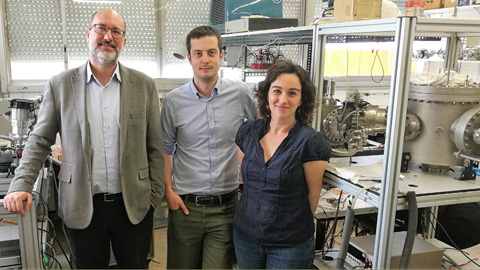Organic light-emitting diodes become brighter and more durable

28/05/2018
Organic light-emitting diodes (OLEDs) truly have matured enough to allow for first commercial products in form of small and large displays. In order to compete in further markets and even open new possibilities (automotive lighting, head-mounted-displays, micro displays, etc.), OLEDs need to see further improvements in device lifetime while operating at their best possible efficiency. Currently, intrinsic performance progress is solely driven by material development.
Now researchers from the Universitat Autònoma de Barcelona and Technische Universität Dresden demonstrate the possibility of using ultrastable film formation to improve the performance of state-of-the-art OLEDs. In their joint paper published in Science Advances with the title ‘High-performance organic light-emitting diodes comprising ultrastable glass layers’, the researchers show in a detailed study significant increases of efficiency and operational stability (> 15% for both parameters and all cases, significantly higher for individual samples) are achieved for four different phosphorescent emitters. To achieve these results, the emission layers of the respective OLEDs were grown as ultrastable glasses – a growth condition that allows for thermodynamically most stable amorphous solids.
This finding is significant, because it is an optimization which does neither involve a change of materials used nor changes to the device architecture. Both are the typical levers for improvements in the field of OLEDs. This concept can universally be explored in every given specific OLED stack, which will be equally appreciated by leading industry. This in particular includes thermally activated delayed fluorescence (TADF) OLEDs, which see a tremendous research and development interest at the moment. Furthermore, the improvements that, as shown by the researchers, can be tracked back to differences on the exciton dynamics on the nanoscale suggest that also other fundamental properties of organic semiconductors (e.g. transport, charge separation, energy transfer) can be equally affected.
About the Group of Nanomaterials and Microsystems (GNaM)
GNaM is part of the Physics Department at the Universitat Autònoma de Barcelona and led by Prof. Javier Rodríguez-Viejo. The group has been deeply involved in the growth and characterization of stable organic glasses, focusing on their thermal, thermodynamic and transport properties. Due to their unique properties including among others higher densities, better kinetic and thermodynamic stabilities and higher modulus, stable glasses are presently at the core of the research in the glass community providing a unique framework for a better comprehension of the glassy state and new opportunities for applications. GNaM is also developing new tools to characterize thermoelectric properties of low-dimensional and disordered solids and has recently founded a start-up company, FutureSisens, for the commercialization of Si-based thermoelectric sensors.
About the Light-Emitting and eXcitonic Organic Semiconductor (LEXOS) group
The LEXOS group is part of the Dresden Integrated Center for Applied Physics and Photonics Materials (IAPP) and the Institute of Applied Physics of the Technische Universität Dresden and led by Prof. Sebastian Reineke. The LEXOS group has a long standing expertise in the research and development of organic light-emitting diodes (OLEDs). The current OLED research comprises stack and concept development, devices optics, charge transport and recombination studies, long-term stability investigations, material development (dopant and emitter materials), and device integration. A second research focus of the LEXOS group is the investigation of excitonic and luminescent systems covering organic and other related emerging materials. The group has a strong expertise in the optical spectroscopy of such systems. On current example is the investigation of organic biluminescence, where luminophores show both fluorescence and phosphorescence at room temperature.
The research leading to these results was partly carried out in projects MAT2013-40896-P: ultrastable glasses: fundamentals and applications and MAT216-79579-R: Phononic transport in anisotropic nanostructures for the development of energy eficient devices, both funded by MINECO and in project ‘Modelling stability of organic phosphorescent light-emitting diodes (MOSTOPHOS)’ funded by the European Union’s Horizon 2020 research and innovation
programme (grant agreement no. 646259). Currently, this concept is jointly explored with cynora GmbH, a world-leading company in development of TADF emitters.
Publication: J. Ràfols-Ribé, P.-A. Will, C. Hänisch, M. González-Silveira, S. Lenk, J. Rodríguez-Viejo, S. Reineke, High-performance organic light-emitting diodes comprising ultrastable glass layers. Sci. Adv. 4, eaar8332 (2018).